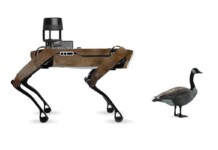 Wal-Mart Canada last week opened its first mega-green supercenter in Burlington, Ontario, which uses heat from the earth in a unique geothermal energy design, diverts 85 percent of its waste, and uses sensors that measure the daylight from skylights, calculating the amount of illumination to add from its energy-saving LED fixtures.
Wal-Mart Canada last week opened its first mega-green supercenter in Burlington, Ontario, which uses heat from the earth in a unique geothermal energy design, diverts 85 percent of its waste, and uses sensors that measure the daylight from skylights, calculating the amount of illumination to add from its energy-saving LED fixtures.
The new Burlington store is expected to use 60 percent less energy than the typical supercenter and to reduce carbon emissions by an estimated 141 tons.
“We’re determined to build the greenest stores on the block, and our Burlington store puts us one step closer,” said David Cheesewright, Wal-Mart Canada’s president and CEO. “We remain committed to being green, not only for the good of the environment, but for the long-term sustainability of our business. There’s a tremendous opportunity to reduce our construction and operating costs and to pass those savings on to our customers, who are looking for lower prices now more than ever.”
Overall the goal for every Wal-Mart Canada store this year is to become 30 percent more energy efficient.
Wal-Mart employs a Chief Energy Conservation Officer, who says, “Demonstration stores like this one prove that conservation and comfort can be brought together for the benefit of shoppers and employees.”
This is the first time a large-scale Canadian retail operation has used geothermal heating and cooling technology. It starts with 15 km of plastic piping buried under the parking lot. The system brings into the store heat during the winter, and deposits heat back below the ground in the summer.
The daylight harvesting system uses skylights to refract daylight throughout the store and light sensors to monitor the amount of natural light available, which dims, raises, or turns off the LED lighting as needed.
The store is powered 100% by renewable power sources like wind and low-impact water power through Bullfrog Power, a provider of “green” electricity in Ontario and Alberta.
In-floor radiant heating and cooling system circulates water to transfer heat and cold instead of air vents, requiring less electricity.
The refrigeration system uses an environmentally preferable CO2, which is 90% more environmentally friendly.
Meanwhile, the heat from refrigeration system is captured and reused to the heat store.
Motion-activated LED lights in its refrigerator and freezer cases reduce energy use when no one is around. And, low-wattage parking lot lights as well as LED external signs cut electricity use.
While increased insulation on the roof reduces heat and cooling loss, white roof membrane deflects sunlight by an estimated 85 per cent to reduce heat gain in summer.
Concrete floors, instead of carpet or tile, reduce excess materials and the need for harsh chemical cleaning products
And finally, the close proximity to Burlington’s GO train station and municipal bus system allows for easy access to store by public transit.
During the construction phase, recycled, locally-sourced and low- or zero-VOC materials were used, and up to 75 percent of the construction waste was diverted from landfills.
On its shelves the store offers customers hundreds of environmentally preferable products ranging from organic produce, to environmentally preferable cleaning products and paper products, to CFL light bulbs — and for the first time, Wal-Mart offers customer a recycling center which even includes streams for those CFL bulbs.
Wal-Mart Canada has three long-term environmental sustainability goals: 1. To be 100 per cent supplied by renewable energy; 2. To produce zero waste; 3. To provide environmentally friendly products to customers.
The Burlington project is the second in a line of marquee projects from the retailing giant after the September launch of its new zero-waste head-office outside Toronto.



















